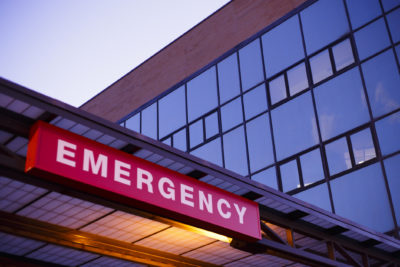
When your body sends you intense signals like these, it’s clearly in distress for one reason or another. You know you need to respond quickly by calling 911 or going to the emergency room. But what happens next?
Identifying your symptoms
“I hope you’ve never had a heart attack. I also hope you’ve never had a panic attack. That’s because they both feel awful – and have some of the same or very similar symptoms,” writes Stephanie Dolgoff, deputy director of the Hearst Health Newsroom, in a Good Housekeeping article. “But only one is imminently dangerous, and that’s a heart attack. A panic attack, on the other hand, may make you feel like you’re having a heart attack (or something is terribly wrong with your physical health), but it’s typically gone in roughly 20 minutes, with no negative impact on your body except maybe the need to take a nap because all that adrenaline coursing through your veins can wipe you out.”
In other words, your body may respond to a mental health condition, such as an anxiety disorder or panic attack, by showing signs that aren’t far off from those caused by a medical emergency, like a heart attack.
According to the Cleveland Clinic, “Symptoms of an anxiety disorder can resemble symptoms of a heart attack or another health emergency. If you’re experiencing an anxiety attack for the first time, or you’re concerned in any way about your health, call 911 or head to the nearest ER. A healthcare provider will check you for serious or life-threatening conditions.”
The Cleveland Clinic website lists some of the general symptoms of an anxiety disorder as:
- Cold or sweaty hands.
- Dry mouth.
- Heart palpitations.
- Numbness or tingling in hands or feet.
- Muscle tension.
- Shortness of breath.
Mental symptoms:
- Feeling panic, fear and uneasiness.
- Repeated thoughts or flashbacks of traumatic experiences.
- Uncontrollable, obsessive thoughts.
Behavioral symptoms:
- Inability to be still and calm.
- Ritualistic behaviors, such as washing hands repeatedly.
- Trouble sleeping.”
In some cases, the symptoms can be severe. Panic disorder – marked by sudden panic attacks – is one type of anxiety disorder. According to the Cleveland Clinic website, “these attacks often feature stronger, more intense feelings than other types of anxiety disorders.”
If your symptoms come on quickly and you’ve never felt them before, it can be overwhelmingly scary and confusing.
“I used to get pretty awful panic attacks and I didn’t know what was happening. I didn’t have anybody to talk to about it and I didn’t know what to do,” said the singer Pink in an Instagram video shared by SELF. She made several visits to the ER before understanding what was happening, according to the article. “I would feel like I was having strokes, like, stroke symptoms, it was terrifying.”
Arriving at the ER
When you get to the emergency room, several things often happen in quick order. If you have heart attack or panic attack symptoms, they will immediately give you medical tests that might look something like this, according to Good Housekeeping:
“If you head to the ER with any of the symptoms above, a triage nurse or emergency physician will take steps to diagnose or rule out a heart attack, says Dr. [Glenn] Levine. They’ll start by talking to you about how your symptoms came on, exactly what they feel like, and about your health history. Then they will likely give you an electrocardiogram (EKG) which measures electrical signals in your heart, and test your blood levels of the protein troponin, the presence of which can indicate damage to your heart. If they’re still not sure, there are further tests they can do to figure out if you’re having a heart attack or whether something else may be going on.”
If doctors discover any urgent medical conditions, they will move to treat you right away. If they rule out other health issues and determine your symptoms may be caused by acute anxiety – perhaps your first panic attack – they may refer you to follow up with your doctor or a mental health professional at a later time.
“Panic attacks usually only last for several minutes. Sometimes an individual may overcome it on their own, but medical intervention is sometimes required. Doctors will commonly use benzodiazepines, a class of sedative drugs that are very effective in decreasing symptoms of a panic attack,” according to an article in Healthline.
“If you continue to have panic attacks, you may be developing panic disorder. It’s important to see your doctor to exclude other causes of the attacks, including thyroid disorders or heart problems, especially if you are experiencing chest pain,” emergency physician Robert Glatter, MD, told Healthline.
Getting immediate help
Doctors say to err on the side of caution and seek professional help when it comes to sudden, potentially life-threatening symptoms like these. For some medical emergencies, minutes count.
“If you’re having an anxiety attack and unsure whether you should head to an ER or not, it’s better to go. Healthcare professionals can make sure you’re OK and give you any necessary treatment,” according to the Cleveland Clinic.
Following up

“It’s important to see your doctor to develop a treatment plan that may include talk therapy, medications, or other techniques,” adds Dr. Glatter to Healthline.
While sudden symptoms are alarming, over time, getting a better understanding of why they’re happening – and finding appropriate treatment – may help these situations feel less scary.
For more information on this topic, please visit:
https://genesight.com/blog/patient/what-are-the-treatment-options-after-a-mental-health-emergency/
https://genesight.com/blog/patient/a-roadmap-for-understanding-panic-attacks/
https://genesight.com/blog/healthcare-provider/should-mental-illness-be-treated-in-the-er/
Our articles are for informational purposes only and are reviewed by our Medical Information team, which includes PharmDs, MDs, and PhDs. Do not make any changes to your current medications or dosing without consulting your healthcare provider.
The GeneSight test must be ordered by and used only in consultation with a healthcare provider who can prescribe medications. As with all genetic tests, the GeneSight test results have limitations and do not constitute medical advice. The test results are designed to be just one part of a larger, complete patient assessment, which would include proper diagnosis and consideration of your medical history, other medications you may be taking, your family history, and other factors.
If you are a healthcare provider and interested in learning more about the GeneSight test, please contact us at 855.891.9415. If you are a patient, please talk with your doctor to see if the GeneSight test may be helpful.







